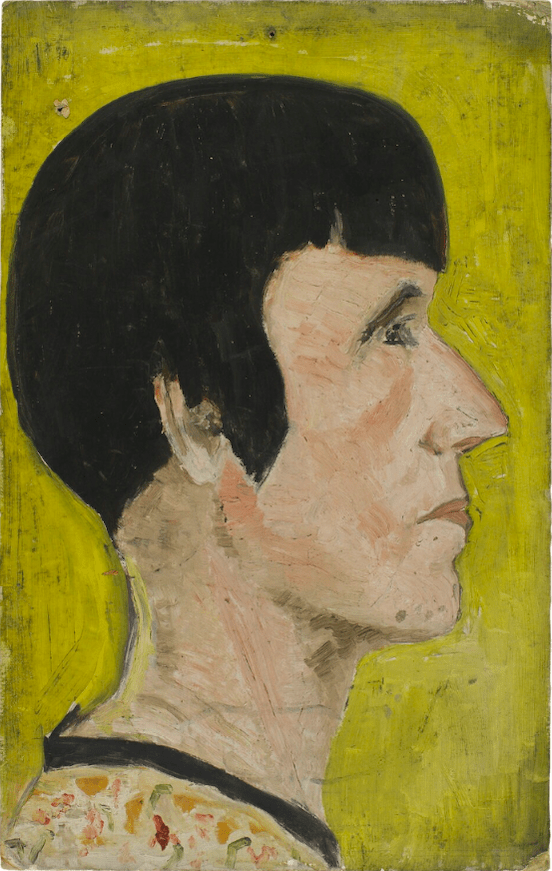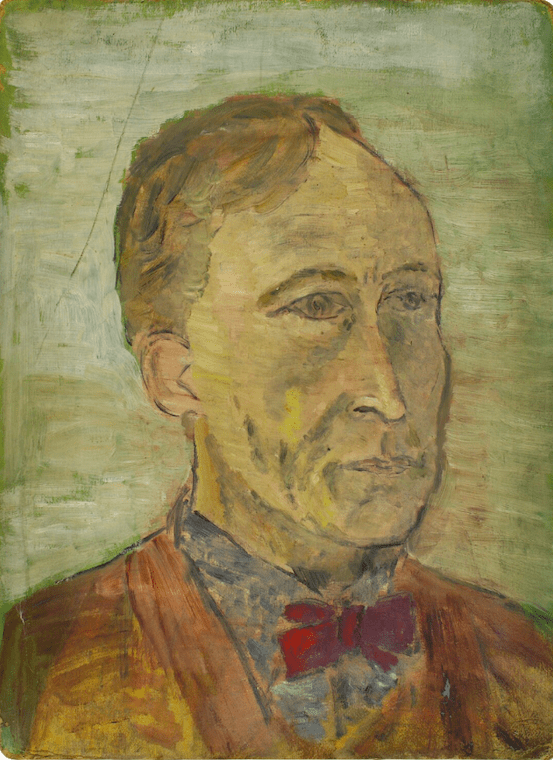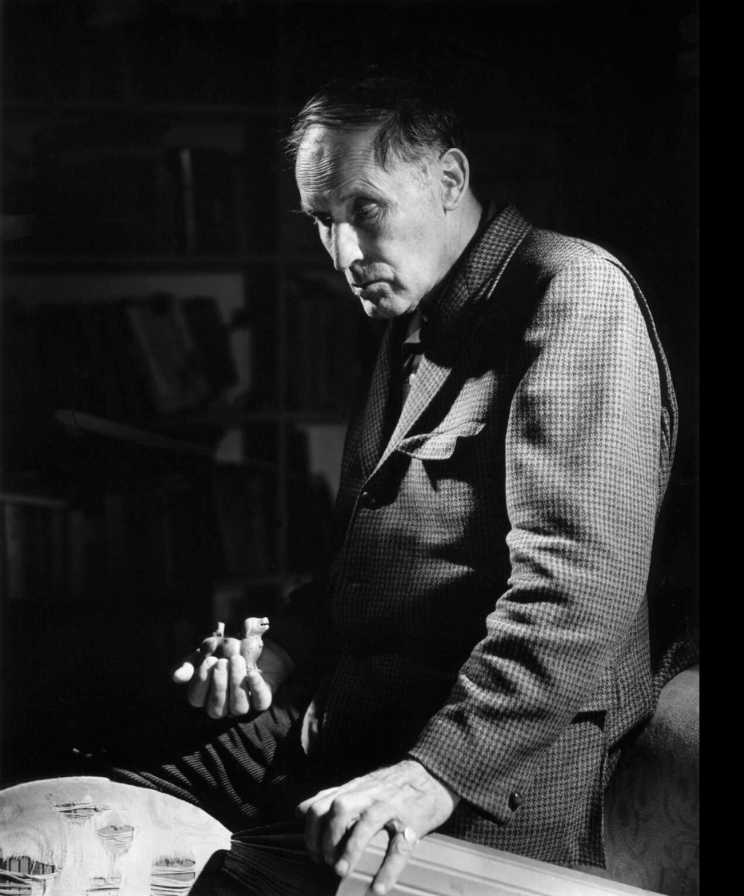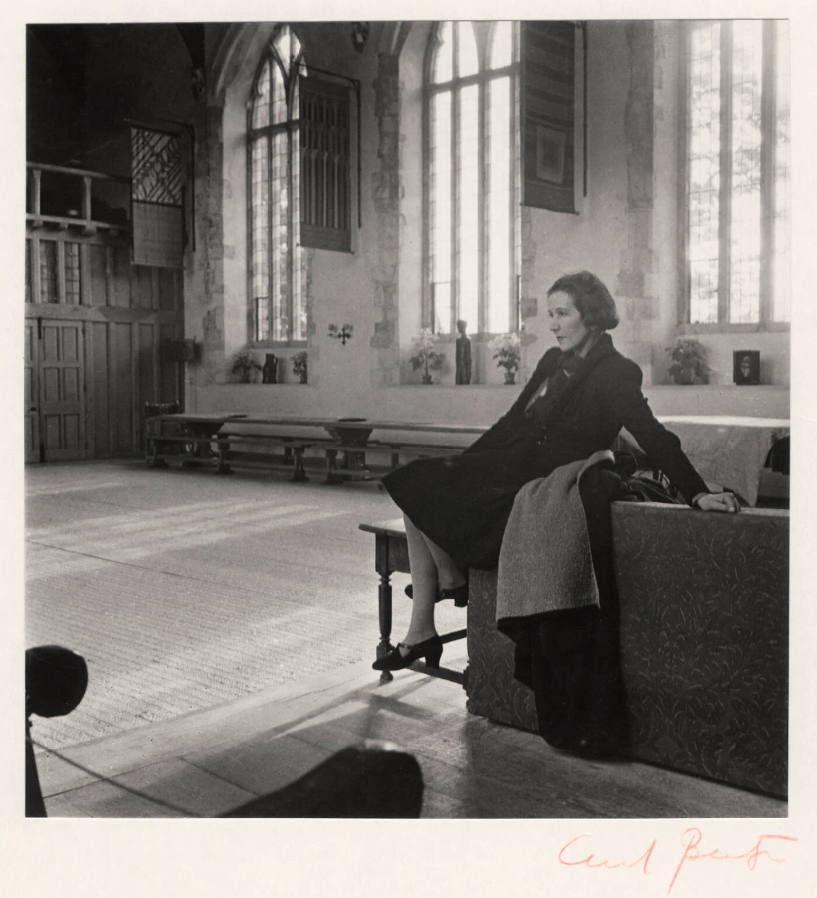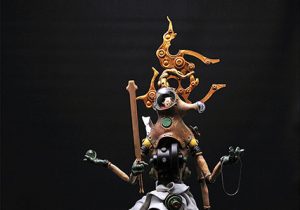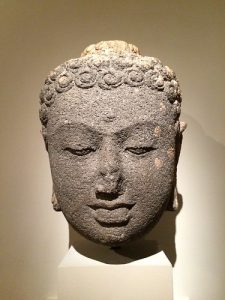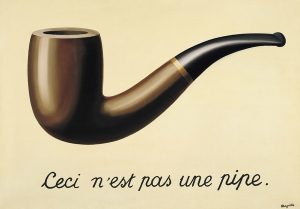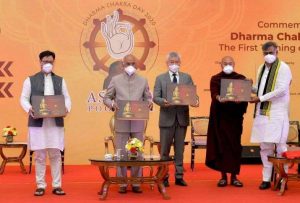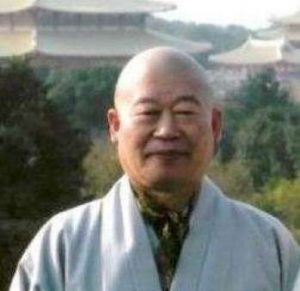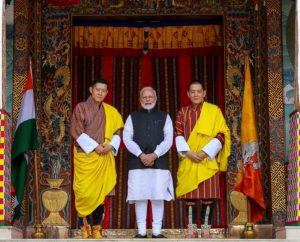We were recently at a lovely dinner party for four couples and the topic of a “fantasy dinner party” came up. We went around the table asking: “If you could invite any three couples from all of history for a dinner party, who would they be?” When it came time for my answers, the requirement was amended: “. . . and they have to relate to dance and Buddhism.”
After a bit of thinking, I said: “I’d invite Laurie Anderson and Lou Reed; Ted Shawn and Ruth St. Denis. They’re giants of performance and got the world dancing. Then, I’d invite Arthur Waley and Beryl de Zoete.“” I learned that all of the dinner guests at our party knew Lou Reed; six knew Ted Shawn; five knew Laurie Anderson and Ruth St. Denis; but Beryl de Zoete and Arthur Waley were mysteries.
Imagining such a fantasy dinner party is an illuminating exercise, especially when questions from one guest can be directed to, and answered by, another. Each of the individuals on my guest list advanced Buddhism in the West. Lou Reed (1942–2013), lead singer of the rock band Velvet Underground, concluded his life doing a powa ritual yoga accompanied by his wife, avant-garde composer Laurie Anderson (b. 1947), who is also a practicing Buddhist. “Father of American Dance” Ted Shawn (1891–1972) and his wife, the renowned dancer Ruth St. Denis (1879–1968), were inspired by ancient cultures and Asian religions. They visited many Buddhist societies on a tour of Asia in 1925–26, seeing pristine Buddhist dances, and documenting ancient dance traditions. Shawn was also teacher of Martha Graham, Charles Weidman, and Doris Humphrey, some of the originators of American modern dance.
Today my purpose is to re-introduce the two now lesser-known British translators Arthur Waley (1889–1966) and his partner-in-life for 44 years, Beryl de Zoete (1879–1962). Waley was from a German Ashkenazi Jewish family living in London before the First World War. It was a dangerous time. Arthur changed his surname to Waley in 1914. His Mother would tell people they were “strong Anglicans.” Waley was much-loved, but his manner was plain and quiet. He spoke sparingly and was comfortable with long silences. Beryl de Zoete was from a Dutch family also living in London. She was 10 years older than Waley. De Zoete was a dancer, dance teacher, dance critic, dance researcher, and translator. She was a graduate of Somerville College, Oxford. Waley attended Kings College, Cambridge.
Arthur Waley and Beryl de Zoete met at a party thrown by Edith Sitwell in 1918. Their circle of Bloomsbury set intellectuals, free spirits, and aesthetic humanists, was heady: dancer Uday Shankar, anthropologist Claire Holt, dance theorist Emile Jacque-Dalcroze, and Balinese-Russian born expat Walter Spies, among them. Waley was a classicist who could read and write in English, French, German, Italian, Spanish, Portuguese, Dutch, Hebrew, Sanskrit, as well as classical Latin and Greek, when he was hired in 1913 by the British Museum as Assistant Keeper of the new department of Oriental Prints and Scrolls. This level of linguistic skill is prodigious and in the manner of Waley’s contemporary, Italian explorer of Buddhism Giuseppe Tucci. Like Tucci, Waley had an ability to conceive of past times. Orientalism in this early 20th century scene meant the study of Asian cultures, arts, and languages. Waley and de Zoete were Orientalists.
The British Museum had a mountain of very old Chinese and Japanese scrolls that needed to be catalogued. They hired a pair of Bloomsbury poets to handle the task. The museum had produced an index of paintings by 1922, and rocked the literary establishment with the publication of Waley’s Chinese poems in the process.
This juncture—at which Waley saw the association of an ancient poetic language with these profound and unknown works of classical Chinese art—was when he embarked upon a personal aesthetic journey through language, almost as if someone working in art brut would create a universe unto himself. Waley taught himself classical Chinese, more specifically classical Chinese used to discuss art. Waley’s superior at the museum, Lawrence Binyon, was a poet and dramatist. There were two poets in charge of cataloging classical Chinese and Japanese paintings at the British Museum. Among other sensitivities, Waley was fascinated by how time changed words; and how words transcended time. He translated the poems on the Chinese scrolls in his new style, which is beautiful and has been cleverly described as “Mandarin English.” Waley believed in recreating, not reproducing, great literature. These two camps of translation were being defined in those days.
Western society had never before encountered these poems. Waley’s first book of Chinese poems struck like a thunderbolt in 1917. This was all unknown, of a piece with fine art and religion and philosophy. Waley’s writing is inseparable from Buddhism inasmuch as are China and Japan. Waley introduced the 20th century literary world to ancient China. His first book of poems included a section introducing Bodhidharma. Waley’s 1942 success was a translation of the popular 16th century Ming dynasty tale Journey to the West by Wu Cheng’en, otherwise known as Monkey. Like work in the other genres in which Waley translated, his translation of Monkey is still much admired. The Zen Centre in London has published a comic book version. Waley’s Monkey has been used as the basis for countless performances and productions.
Arthur Waley’s enormous output includes Japanese Noh plays, ballads from Dunhuang, the Tripitaka, works by Lao Tzu and Confucius, and original books such as Introduction to the Study of Chinese Painting. He translated the Tale of Genji by Murasaki Shikibu, taking eight years, and dedicating the romantic first book to Beryl de Zoete. Waley was charged with translating and cataloguing the paintings brought back by Aurel Stein from his travels to Dunhuang. From introducing unknown Chinese and Japanese Buddhist treasures, to communicating something of the poetic vitality of the written language, Waley is responsible for many of the West’s first impressions of China and of Buddhist culture. Again, like Tucci, Waley was comfortable with languages in completely different scripts, making him also a master interpreter of symbols for language. Tucci believed that unless he could read and appreciate a culture’s poetry, he did not understand the language. Waley was a poet himself who understood the poetry of other languages.
American writer Ernest Fenollosa, concerned about the near extinction of Japanese Noh theater, took Noh lessons from one of the last remaining Noh masters in the early 20th century, Umewaka Minoru. Fenollosa took notes and intended to write a book titled Noh, or, Accomplishment. Sadly he died before he could write it. His secretary was a poet from Idaho named Ezra Pound. Pound was given the notes by Fenollosa’s widow and prepared and published this book.
It was also Pound who encouraged Waley to continue to translate classical Chinese literature—even though he was not an admirer of Waley’s style of language. Pound was inspired by Zen’s brevity and indirect power. Pound also advised Waley to translate Japanese Noh plays. In 1921, Waley published Noh Plays of Japan, considered today to be some of the most beautiful and compelling translations of Noh. The better-known thread of this story is that W. B. Yeats was secretary to Pound, whose Noh influence was seminal to Yeat’s own English Noh plays—the Cuchulain cycle. This is quite a poetic lineage: Umewaka Minoru, Ernest Fenellosa, Ezra Pound, Arthur Waley, W. B. Yeats. Pound translated sections of Noh plays in his inimitable economical style. Comparing Pound to Waley in their translations of Noh is a lesson in early 20th century poetry. The one is radical, the other is exquisite.
The intellectual and artistic potential of language thrilled the imagination of Waley, who noticed, almost lamented, that after the success of One Hundred Seventy Chinese Poems, that not a single reviewer commented on how his new style was an experiment in English literary translation. Waley and de Zoete were together most of the time, unless she was traveling. She traveled widely. De Zoete, sometimes called “the first global dance critic,” wrote insightful accounts of dance in Ceylon, Bali, and southern India. Waley commented that part of her excellence was that “she knew when to put down the methods of the analyst and adopt the methods of the artist.” Perhaps she saw this in him as well? She surely recognized Arthur’s genius. They were happy Bloomsbury fringe bohemians in all their simple eccentricity. While he worked in their apartment, they would share mutual interests in their writing work during the day. At night, she would review ballet for The Daily Telegraph, the New Statesman, and others.
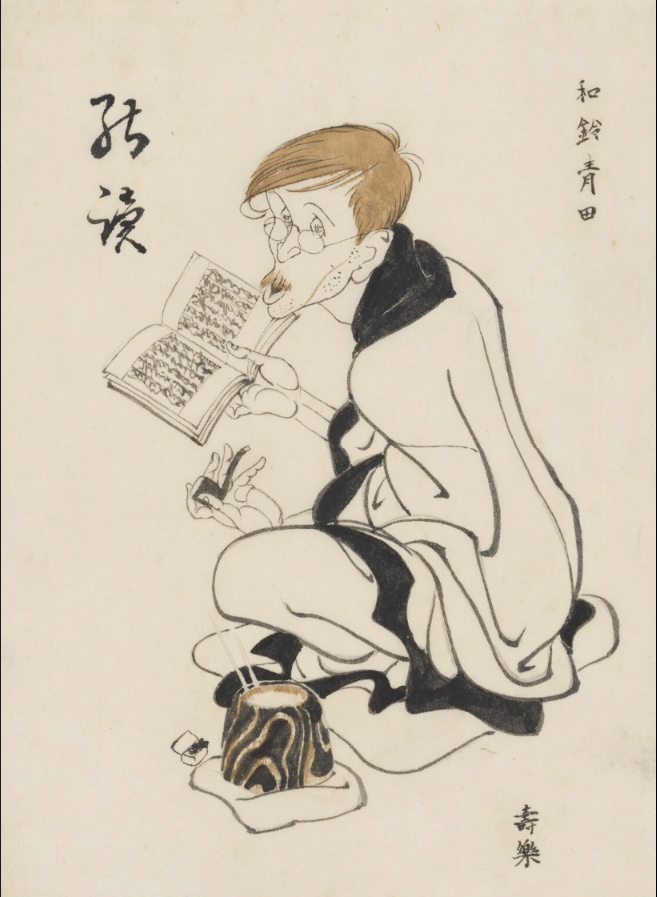
As a translator, de Zoete was distinguished. She translated an Italian modernist novel in the mode of James Joyce; a psychological novel from the German; Italian works on Franciscan architecture, and more. She taught dance using the method of Emile Jaques-Dalcroze, who invented a system of fundamental movements called Eurhythmics, which was as much a theory of learning music through movement as it was a movement practice. De Zoete first saw Ceylonese dance in Paris, at an exhibition, and went on to write what is considered by some to be a travelogue, but is used as a standard work: Dance and Magic Drama in Ceylon (1957). It follows on her Dance and Drama in Bali (1938) and The Other Mind: A Study of Dance and Life in South India (1953).
De Zoete introduced the concept of “the other mind” in regard to ancient Asian dances. It was a translation of a term used in Bali and taught to her by Walter Spies. The “other mind” of dance in Bali was the state of ecstasy entered into by the dancers before they perform their sacred and energized dance. De Zoete studied south Indian traditions and their localized island variants. She recognized that it was a quality of mind that distinguished the finest dancing. She said of herself: “I am not very good at being learned, but everything I speak of I have seen with my own eyes and felt with my own heart.” Hours of film and more than 2,500 photographs are in the de Zoete collection at the Horniman Museum in London, where, I am proud to say, some of our own dance work is on display and owned by the museum.
Waley wrote of de Zoete: “Unlike the rest of us, Beryl comprehended the various dance forms and provided informed commentary.” While she was away from London in India and Ceylon for three years, Waley moved to the Russell Hotel and had no published output. When she returned, his publishing continued. He wrote captions for one of her dance photography books, and the introduction to her posthumously collected essays The Thunder and the Freshness (1963). Beryl de Zoete died in 1962 of a genetically transmitted and terrible disease, Huntington’s Chorea. It is a cruel irony that someone who dedicated her entire life to dance would suffer the mad loss of physical control named as a dance. Waley cared for de Zoete until she died. He died four years later of cancer and a broken back. Refusing all medication, he wanted to be conscious at his death, and so friends played records of Hayden symphonies and read his favorite poems to him.

Huntington’s Chorea is genetically transmitted, and the onset of de Zoete’s disease was unusually late—during her 70s. Remarkably, even after the puzzling and bizarre onset of this disease, with its psychotic states and hallucinations, as well as palsies, Beryl traveled to Brazil to attend a music conference, and there she was treated by psychiatrists for psychotic breaks. After that, in 1957, at Waley’s request, she joined a delegation to Peking on his behalf.
Despite his eminence as a translator and acknowledged erudition, Arthur Waley never visited Asia, nor heard modern Chinese or Japanese being spoken as native tongues.
Perhaps Arthur Waley and Beryl de Zoete had an “other mind” of their own. They worked as team, nearly inseparable. They lived frugally. Famously frugally. He always dressed plainly; she wore a lot of rings. He spoke sparingly; she liked to talk. More than one friend leaving a reminiscence of them said that when they invited people to dinner at their Bloomsbury apartment, it was always baked beans and good wine. Waley was awarded the OBE by the late Queen Elizabeth II.
There I was imagining a fantasy dinner party and no one knew the couple I really wanted to meet: Arthur Waley and Beryl de Zoete. Waley and de Zoete, a couple truly in love, living a life of the mind of which few could conceive. They had the highest regard for the culture, wisdom, and the beauty of Asia, and built bridges that were crossed by more democratic and deeper explorers of Buddhism to come. But for being classy and independent, for bringing the world Noh plays, Monkey and the “other mind” of Asian dance, they stand apart. The beauty of their words is timeless. Few writers have captured elusive dance with such grace. Arthur once shared a note of appreciation for Beryl’s work by citing his own translation of the Noh play, Hagoromo.
But not yet are they numbered,
(Zeami, 14th century)
The dances of the East.
The 96th Anniversary Lecture of the Buddhist Society in London: “Other Minds: Arthur Waley and Beryl de Zoete”
See more
The World’s First Global Dance Critic Was a Victorian Aerobics Teacher (Atlas Obscura)
Core of Culture
Related features from BDG
The Very Long Life of Bugaku
Atsumori
Hagoromo


